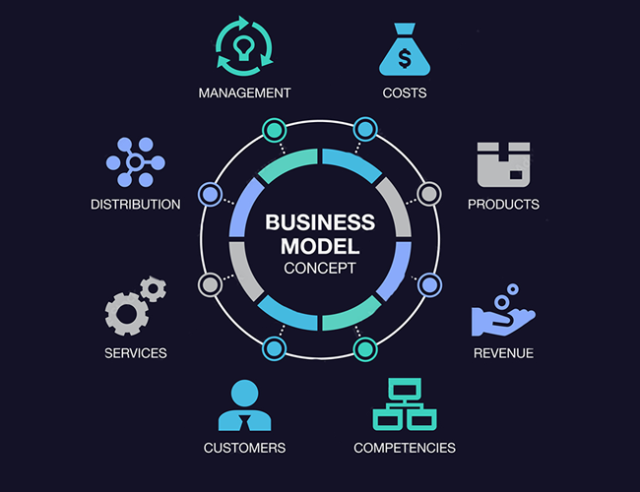Strategy Development
Strategic management is an integrated process to define a set of managerial decisions that determines the long-term performance of an organization. Organization system links strategy to performance through developing environmental & industry research, strategy, performance, and control & feedback. We support our clients to unlock big strategic moves for growth, innovation, sustainable existence, and prosperity. We recognize the globalization and environmental changing when we conduct strategic management projects
People in a project, department, or organization can be incredibly busy and productive but this doesn’t necessarily mean that the system is performing well. The prerequisite for a high level of organization systems’ performance is that all its members pull into the same direction. This is exactly why you need a strategy. It acts as sense-making tool for all members and thus ensures that individual actions are aligned. Strategy development experience with Seven Jobs will assure top management, divisions, departments, and team members are aligned to fulfill organization’s mission and achieve organization’s strategic goals for growth, stability, or retrenchment strategy
Growth
Supporting our clients to expand internally and externally through developing concentration (vertical & horizontal) and diversification (concentric & conglomerate) growth strategies
Stability
Helping our clients to continuing its current activities without any significant change in directions and ensuring profitability through developing stability strategies
Retrenchment
Supporting our clients to enhance improvement of operational efficiency through turnaround strategy
Performance Management
Working with our clients to design, implement, and evaluate a SMART performance system using hybrid model of methodologies to improve effectiveness and efficiency


Strategy Formulation
1. determining corporate directional,
2. conducting environmental scanning, and
3. preparing the masterplan.
Off course, we implement integrated organization system and map all functions with the strategically change the organization is planning to make
We support our client, implement analytical process of selection of the best suitable course of action to meet the organizational goals and objectives

Organization
& Restructuring
Organization design is the process by which managers select and manage aspects of structure and culture so that an organization can control the activities necessary to achieve its’ goals. Change the structure will affect the design as well, we at Seven Jobs understand the integration between structure and design. We at Seven Jobs manage to study the actual and future value-chain models as the baseline for structure & design recommendation of change
Organizational structure can also be considered as the viewing glass or perspective through which individuals see their organization and its environment. Organization can be restructured in many different ways, depending on its’ strategy
We provide a unique techniques to select the best-fit organization design that will help our clients to achieve their strategic goals and objectives

Business modeling
Value-chain, is a set of value-creating activities that begin with the raw materials coming from suppliers, moving on to a series of value-added activities involved in producing and marketing a product or a service, and ending with distributors delivering the final goods into the hand of the consumer
Integration of value-chain, SJ to study vertical and horizontal integration of value-chain:
1. Vertical Integration – the degree of which the company operates vertically on an industry’s value-chain from extracting the raw materials to manufacturing to retailing, including backward and forward integrations. Vertical integration will benefit the companies by allowing them to control process, reduce costs, and improve efficiencies in which digitization initiatives will support to achieve these objectives
2. Horizontal Integration – the degree of which the company operates in multiple geographic locations at the same point of an industry’s value-chain, this may support entering new markets, increase market share, increase range of products (products portfolio), boost revenues, and diversified services offered by the company
Design value-chain, SJ to perform three steps in designing value-chain analysis:
1. Examine each product line’s value-chain in terms of various activities involved in producing a product or a service for each firm subject to study.
2. Examine the “linkages” within each product line’s value-chain, linkages are the connections between the way one value activity is performed and the cost of performance of another activity, to define the digital transformation change competitive advantage
3. Examine the potential synergies among the value chains of different product lines or business units, to design the cost of joint production of multiple products can be lower than the cost of separate production – example of economies of scale, for more competitiveness and productiveness status

Six Sigma or/and Lean
1. Cost optimization.
2. Improve operational efficiency, produce more with less.
3. Improve effectiveness of operations, achieve strategic objectives and production target
Financial Services
| Modeling | Five years financial modeling, business projection, market overview in addition, five years projected P&L and cash flow |
| Budgeting | setting up organization’s annual master budget and forecast and compete predictive P&L and cash flow |
| Reporting | Supporting clients to report monthly, quarterly, and yearly financial statements including receivables analysis |
| Accounting & GL | 1.Providing standards operating procedures (SOP) best practices, summary list of findings, understanding department functions, evaluating system access rights and segregation of duties, identify control weaknesses. 2.Providing a comprehensive review for transactions and GL accounts, expenses allocation, and analysis report. 3. setting up and review fixed assists register, fixed assets coding, and fixed assets depreciation calculation |
| Feasibility Study | Supporting our clients to prepare an assessment of the practicality of a project or system; aims to objectively and rationally uncover the strengths and weaknesses of an existing business or proposed venture, opportunities and threats. In addition, defining the resources required to carry through, and ultimately the prospects for success |
| Corporate Finance | Supporting organizations to manage deals with how to address funding sources, capital structuring, accounting, and investment decisions |

Due Diligence
Business Valuation

Internal Audit
Human Resources
Supporting client to deisign and implement a strategic and coherent approach to the effective and efficient management of people in an organization
Recruitment
Supporting our clients in managing hiring decisions; to input the organization with the most talented people
Manpower planning
Defining human capital budget and headcounts, supporting workforce planning
Training
Supporting in reflecting organization value into training programs to enhance organizational culture such as performance, planning, change management, organizing, excellence, leadership, ethical decision making, leading change, innovation etc.

Quality Management
The processes that ensure that an organization, product or service consistently functions well. It has four main components: quality planning, quality assurance, quality control and quality improvement
GMP
Supporting in implementing system for ensuring that products are consistently produced and controlled according to quality standards
ISO
Helping our clients to implement ISO international standards
Total Quality Management
Supporting to engage all team members to participate in improving processes, products, services, and the culture in which they work

Technology Transformation
It’s is the process of invention, commercialization, and improvement of technology. It is an exponential or hyperbolic process whereby new technologies make the invention of new technologies easier and faster resulting in accelerating change. It’s a major part of organization development; Seven Jobs not only believes in technology but it designs and implements fully automation, integration, and transformation projects that lead organizations to enhance performance as an end result. Seven Jobs has invented “Straformance”
Automation
Transforming organization processes to be performed by technology
Integration
Helping organization to bringing together the component of sub-systems into one system
Digitizing
Helping our clients in implementing process of invention, commercialization, and improvement of technology

Operation Control
S&OP
Supporting our clients to conduct an integrated business management process through which the executive/leadership team continually achieves focus, alignment, and synchronization among all organization functions
Re-engineering
Supporting managers to redesign how tasks are bundled into roles and functions to improve organizational effectiveness
SOPs
Documenting practical standards to operate the business after applying reengineering exercise. SOPs provide a reference for all stakeholders to ensure that change has reached all business processes, all employees are aware of the change, and they practicing it in their daily activities


Marketing
Branding
Supporting to apply the process of giving a meaning to specific organization, company, products or services by creating and shaping a brand in consumers’ minds
e-commerce
e-marketing
Internal Design

Startups Support
We are committed to support startup business to help them to grow to achieve their objectives through:
1. designing and formulating business plans and strategies,
2. conducting structuring,
3. implementing initiatives & programs
4. designing value-chain and business process engineering,
5. preparing budgeting and forecasts,
6. and preform action plans
Seven Jobs experts work hand-in-hand with startups’ team members to reach the expected growth level within the defined timeframe

Digitizing & Technology Transformation
A technological change is an increase in the efficiency of a product or process that results in an increase in output, without an increase in input
1. Automation:
Process performed by technology
2. Integration:
Sub system to work together as one system
3. Robotic Process Automation (RPA):
Known as software robotics, uses automation technologies to mimic back-office tasks of human workers, such as extracting data, filling in forms, moving files, et cetera. RPA is a technology that uses software robots to perform tasks that humans usually do on computers; such as data entry, form filling, or file moving. RPA can help businesses improve efficiency, accuracy, and compliance by automating repetitive and rule-based processes across different applications and systems. RPA is different from traditional automation because it can interact with any software or website that a human can, without requiring any integration or modification of the existing infrastructure
